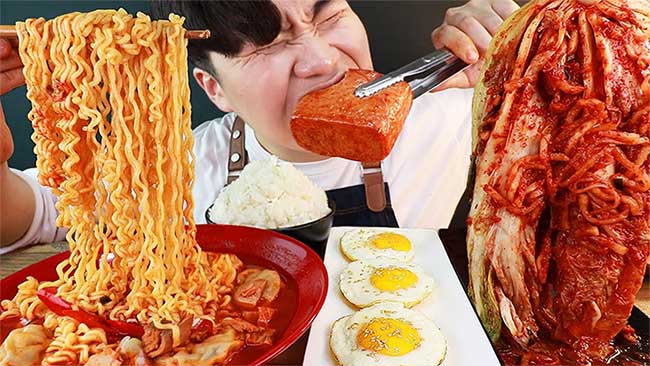Why do we like watching others eat?
Mukbang videos have become a popular trend that proves that we like to see others eat in ways we can't. But why is it so attractive?
The sensitive show actor, Terry Crews, is almost screaming. You might think he's being tortured. However, this is just a part of the entertainment entertainment program on YouTube called Hot Ones.
For centuries, people have always enjoyed watching other people eat horrible and horrible food. The procedure may vary by location, but this is a form of entertainment.
In fact, we like competitions like hot dog eating and often hold eating competitions. On reality TV, we have a contest to eat smelly dishes like Fear Factory or Epic Meal Time on YouTube.

People are always interested in watching other people eat horrible and horrible food.
Now we also have famous food challenges like Mukbang on YouTube (Mukbang is known as an unlimited eating day). Indispensable programs such as Hot Ones, in which celebrities will introduce their movies through the challenge "tears" like eating spicy chicken wings.
The challenge of limiting yourself in a safe way
"The food challenge seems to be the most popular trend on YouTube right now ," Josh Scherer, a chef, former food journalist and owner of Food Fears on YouTube, told Mashable.
Click on a video and you find it hard to stop watching until it reaches your tolerance level. And the person who eats can continue? Will they survive until the next bite? How will they endure it?
Creators continue to make entertaining content related to horrible food. Although the emotional response spectrum is quite small and mostly annoying, there are millions of views because people are constantly fascinated by this content.
In developmental psychology, there is a theory called benign masochism . This theory may contain answers that we cannot ignore.
Benignity is a theory created by Paul Rozin, a psychologist at the University of Pennsylvania. He realized that people were interested in experiencing scary and difficult feelings in a safe environment where they didn't really have to go through anything.
Like roller coaster, thriller, here we have a 9kg cheese hamburger. The increased amount of adrenalin makes people feel threatened with life.

Yang Soobin - a familiar face to those who like to watch Korean mukbang. (Photo: Bilibili).
'It's basically like you hurt yourself a little, but not in a dangerous way , ' says Josh Rottman, a professor of developmental psychology at Franklin and Marshall College. He investigated the role of disgust in child development. 'Benevolent eroticism seems to be a common joy. It makes us feel like we put ourselves in danger. But we do it the safe way. '
In addition to the 'joy' of benign pornography, the horrific videos that attract viewers are explained by the development of children.
'My idea of what happens in Hot Ones and all those who are watching others eat is that choosing food is really a difficult problem for people , ' Rotttman said.
He explained that deciding what should or should not be eaten is part of the growing challenge, especially for children, but also throughout our lives. A study of what can hold a child's attention shows that 'things related to survival' bring an interesting feeling when looking at them.
We may not realize this when we watch videos on YouTube, but actually we are watching others trying to limit what is and cannot harm them. This brings about developmental value and simulation formation in our brain. A child-like impulse about what is safe and what does not form a fascination leads our adult to the habit of watching YouTube videos.
'This may be temporary and not really teach us anything, but in the long run is different,' explains Rottman.
Event organizers, television staff, program producers and content creators have relied on the biological attraction and joy of benevolent masochism, even if they actually recognize what that or not.
'Terror draws attention, luring us in. Then when we show it on screen instead of real life, we are in a safe place to learn and enjoy it , '' Rubenking said. 'Content creators have relied on this and created a pretty good effect.'
The creators of this content are increasingly competing. This has led to higher payouts and shows and increasingly bizarre challenges.
'It's no surprise that everything is happening again. The vast majority of content gradually increases in size over time, making us familiar with it. So much more horrible content is needed to keep fans 'reaction.'
Change to be more educational
It is hard to support that creators do only one thing, consumption, even if they understand why this content is appealing. The amount of food created and consumed because YouTube views are viewed as the most wasteful. This can also lead to people being exploited and endangering themselves just to make money.
However, there are also many creators who are figuring out how to harness the hidden power of food, while still expressing their love for food and the desire to provide something to their viewers. surname.
'It's not the best type and I can see counter-logic somewhere, but I know that I, like everyone, have less and less attention span. You have to rise above it and capture people faster than before , ' Scherer said.
The popularity of Hot Ones is not simply from the challenge of eating spicy chicken wings. It's also where celebrities eat spicy foods, giving you the chance to see people who seem 'untouchable' in a miserable position. This turned out to be fun and created a lot of value for promoting in Hollywood. Hot Ones thus became almost a part of the celebrity's media campaign.
Food Fear is similar. However, Scherer tries to include foods that Westerners consider appalling. Differences in context and culture make up the highlight.
'I realize there are a lot of foods that other people find terrible, but I like them , ' Scherer said. 'Liver, kidneys, brain, things like that. The idea started with me telling someone that I was going to cook you a delicious meal from what you thought couldn't be eaten. '
Scherer's ideas have some interesting biological implications. In addition to the existing 'survival' value , it also contains social factors. Rottman explained that having excessive reactions to food can be a way for groups to separate from each other.
'The way we feel awful about food makes us belong to some group. This reaction cannot be faked , ' Rottman said.

Pizza pesto with topping is the beef ball on Food Fear. (Photo: YouTube)
This work also leads to some interesting results. In one not-so-famous episode, Scherer cooked a lot of beef patty (the genitals of the cow) and put it in pesto pizza. The boss of Scherer Link Neal, a YouTube creator, was also the "horrible food" tester, calling it the worst pizza he had ever eaten. This obviously makes us like mozzarella even more.
Still, Scherer encouraged his guests to try the food with an open and relaxed mood when they ate.
'I think that's the beauty of food. It is something that is emotional and vulnerable to people, and the universe , ' Scherer said
In a recent episode of Food Fears, Terry Crews challenged his stamina again. He gagged when he ate the turkey testes. But when Scherer cooked them with a type of pasta and cheese that the Crews liked, the Crews nodded and said, 'It's delicious.'
Turkey's testes turned out to have been a delicacy in the United States, until the current way of food production replaced the concept of eating every part of an animal. Trying cheese pasta with turkey testicles is a horrific sight, but it also contains a lesson. Removing parts of animals because we are not familiar with them is a waste of birds, this planet and your stomach.
When talking about changing his pig gut perspective, Crews said: 'Some days are bad, some are good. Now I'm ready for everything. '
- Why do people like to eat spicy?
- The truth about the "unusual" human eating syndrome
- The consequences of watching movies
- Watching many animations makes children aware of deviations
- The art of hand watching makes the scientific community nod their heads
- Addicts watching TV are at high risk of premature death
- Watching TV helps children reduce pain
- Science entered: Watching football is good but many people are so passionate?
- Why do kids like to watch a movie over and over again?
- 8 best movie viewing apps on Android
- Children with television addiction are more likely to use violence
- Early death 5 years by watching TV
- Watching TV also makes climate change
- Watch a lot of TV, go to the cemetery soon
 'Fine laughs' - Scary and painful torture in ancient times
'Fine laughs' - Scary and painful torture in ancient times The sequence of numbers 142857 of the Egyptian pyramids is known as the strangest number in the world - Why?
The sequence of numbers 142857 of the Egyptian pyramids is known as the strangest number in the world - Why? History of the iron
History of the iron What is alum?
What is alum?